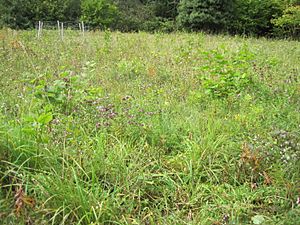Downe Bank facts for kids
| Site of Special Scientific Interest | |

Flowers in Orchis Bank
|
|
| Area of Search | Greater London |
|---|---|
| Interest | Biological |
| Area | 17.7 hectares |
| Notification | 1981 |
| Location map | Magic Map |
Downe Bank is a special nature reserve located near Downe in London. It's managed by the Kent Wildlife Trust. This beautiful area is part of the North Downs and is a Site of Special Scientific Interest (SSSI). This means it's a protected place because of its amazing nature.
Downe Bank is right next to High Elms Country Park. It was also a favorite spot for the famous scientist Charles Darwin. He lived nearby at Down House and often visited Downe Bank. This place even helped him come up with some of his big ideas!
Contents
What Makes Downe Bank Special?
Downe Bank is a large area, about 17.7 hectares in total. The Kent Wildlife Trust manages a part of it, which is about 5 hectares. This reserve has two main types of habitats:
- Hangrove Wood: This is an ancient woodland. It has been a forest for a very long time.
- Orchis Bank: This is a chalk grassland. Charles Darwin knew it as Orchis Bank because many wild orchids grew there. On old maps from 1840, it was called 'Rough Pell'.
Plants and Animals
Orchis Bank is home to many different kinds of plants. You can find special chalk grassland species here. These include plants like toothwort, adder's tongue, and false oxlip.
Many animals also live at Downe Bank. Scientists have recorded up to 31 different types of birds. You might also spot dormice and many kinds of insects. This area is very important because it has stayed almost the same since Darwin's time. Local nature lovers have worked hard to protect it.
Visiting Downe Bank
You can visit Downe Bank by following a footpath. This path goes through the reserve. It connects Christmas Tree Farm on Cudham Road in Downe to Overshaws on Cudham Lane near Cudham. This footpath is part of the Cudham Circular Short Walk.
The entrance to Downe Bank is on Hangrove Hill. There isn't any car parking right at the entrance. The southern part of the reserve is open for everyone to explore. However, to visit the northern part, which is even more important for nature, you need to arrange it with the Kent Wildlife Trust first.
Charles Darwin's Connection
Charles Darwin spent a lot of time at Downe Bank. He loved observing the plants and animals there. His studies of orchids and the insects that pollinated them at Orchis Bank were very important. These observations helped him write his book, Fertilisation of Orchids, which was published in 1862.
Experts believe that Downe Bank also inspired a famous part of his most well-known book, On the Origin of Species. He wrote about an "entangled bank" filled with many plants, birds, insects, and worms. He thought about how all these different living things were connected and had changed over time.
Darwin's Family Memories
Darwin's son, Francis, remembered how much his father loved "Orchis Bank." He said his father enjoyed seeing the different orchids there. Darwin also liked "Hangrove," where he would collect grasses. Francis even shared a funny story about his younger brother, who was proud of finding a new type of grass!
Darwin's daughter, Henrietta Lichfield, also wrote about "Orchis Bank." She described it as a "grassy terrace" with a peaceful view. She remembered seeing various orchids and the old Cudham church spire in the distance.
World Heritage Site Nomination
In 2009, the British Government tried to get Downe Bank recognized as a World Heritage Site. This nomination was called 'Darwin's Landscape Laboratory'. It included Darwin's home, Down House, its gardens, and Downe Bank. Unfortunately, the application was not successful that time.

